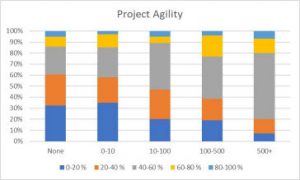
What isn’t clear from the report is the demographic of the survey. Specifically, how many companies were represented nor from what industries. Some information was revealed though. 61% of the companies either don’t have a PMO or have less than ten people within it. The blended statistic of how many of the organisations with more than 10 people in their PMO who are looking for a new PPM solution is the interesting one. Organisations with less than 10 people are far less likely to make the investment.
Challenges for project managers
The survey asked respondents to identify the biggest challenge with their projects. The responses were:
- Resource management 42%
- Prioritization 39%
- Visibility, Reporting 9%
- Project finance, staying in budget 5%
- Other 5%
That resource management as the top response is no surprise. Organisations such as the Resource Management Institute believes that poor resource management is one the main reasons for failure of projects. The issue is wider though, with Professional Services Firms often stating that resource management is their biggest issue. PPM and PSA solutions, such as KeyedIn, look to resolve this problem.
In all sizes of organisation the top two results are resource management and prioritization. However, in organisations with more than 500 people in its PMO, prioritization is the highest of the two. This does not mean that resource management is fixed in those organisations, far from it. It does however mean that real time information and collaboration have an increased importance.
What was interesting, and also called out in a blog, was that organisations without a PMO has the same order of priorities are large organisations. The reasons behind that are not easy to identify. It may be because without a PMO there is no guiding hand. Whereas, in larger organisations resource management is better organised.
Good news for KeyedIn (and others)

For KeyedIn the focus seems to be on addressing the resource management issue. Lauri Klaus, CEO of KeyedIn commented: “PMP professionals are struggling with the challenges of resource management and capacity planning. Every day they find themselves asking questions like, do we have the capacity to tackle these new projects, are our people just busy or are they busy with the right things, or do we have the skillsets to address new digital projects? It’s answering those and many other resource-related questions where KeyedIn has proven so valuable.”
The survey also asked what the reasons for evaluating a PPM solution are. In all cases, no matter what the evaluation timescale, resource management and prioritization were highlighted. For those looking between six and twelve months, visibility (or the production of status reports) was also highlighted as a cause, significantly above the other two. Though still well below prioritisation and resource management.
Project Agility

A subset (331) of the respondents also answered a question on how agile their organisation is. The result was a mediocre 36% on average. When broken down by size of PMO it revealed some interesting findings. 60% of those without a PMO has less that 40% agility, the highest percentage. That number gradually dropped as the size of organisation increased. The top performers, between 60-100% varied across the different sizes of organisation. One might conclude that the systems or organisational processes in place to achieve that vary across the different sizes of organisation. The challenge of growth clearly occurs within PMO’s as well.
What does this mean?
This survey seems short and it is possible that these are only some of the results. However, it is a good snapshot of the pains of project managers from a significant number of people. For KeyedIn it validates their emphasis on resource management with Klaus adding:“With our PPM and PSA solutions, we help PPM professionals automate the planning and assignment of resources for project management and services delivery teams, giving them new levels of efficiency, productivity and visibility.”
What KeyedIn has not done is address the prioritisation issue. Though this is something that would probably need digging into further. Do the respondents mean the prioritisation of projects? A recent HBR article offered some insights on this. Alternatively, requirements prioritisation as highlighted in PMtimes by Martin Schedlbauer. The subtext for the KeyedIn question was “Prioritization – we are constantly trying to hit moving targets”. Slightly ambiguous and a challenge that seems almost as important as resource management.


























